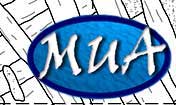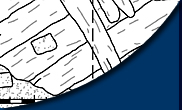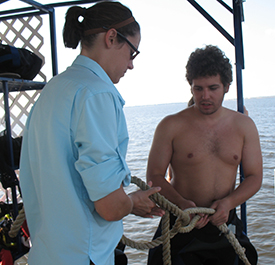
Colleen Reese and Matt Gifford repairing the broken anchor line.
This week, the crew arrived on Monday to find that the barge had shifted during the weekend. The buoys marking the north and south datums of EPII that are usually off the port side of the barge were on the starboard. This was due to a split anchor line. Team 3 performed a circle search and located the anchor line. Once the anchor line was repaired, the barge was pulled back into its original position. With the dive rotation now back on schedule, work continued on EPII with Teams 3, 4, 5, and 6 continuing to dredge the fluff from the amidships and southern units. The dredge spoil from the fluff removal revealed some resin (used to seal liquids in ceramic storage jars), small ceramic sherds, and a treenail. During this work, Teams 1 and 2 dove on EPI to practice their circle searching and mapping skills as well as to experience the wreck site that started the Luna research in Pensacola that they now carry on as excavators of EPII.
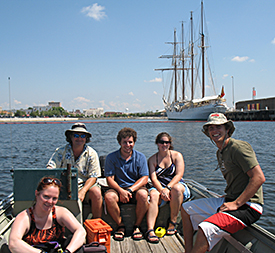
Crew visits the Spanish tall ship, the Elcano on Tuesday. Left to Right: Elizabeth Murphy, Greg Cook, Matt Gifford, Erica Smith, Chris Dvorscak.
At the beginning of the day on Tuesday, the crew worked together to assemble on the barge as quickly and efficiently as possible, even though there was only one working motor craft to haul gear, equipment, and crew to the site. While the barge was being set up, new grids were assembled topside in order to open up two new units on EPII. Most of the day consisted of teams setting and leveling the new grids to prepare for dredging. Later in the day, the dredges were turned on and teams began to put the training they had received in the previous weeks of “fluff” and wall slump dredging in older units to practical use on the new units as excavation by level and careful recording began. On several occasions, teams reported reaching ballast within the first 20 centimeters of sediment! Meanwhile, Greg Cook shuttled students and supervisors over to the Palafox Pier to take a look at the Spanish tall ship, Juan Sebastian de Elcano that had been visiting Pensacola for the past week.
Wednesday was the day chosen for special rotations of teams to learn lab and survey techniques. Team 1 visited the lab, where they worked on artifacts found from last year’s field school and Team 6 practiced surveying methods in Pensacola Bay and Bayou Texar, using the side-scan sonar. The remaining four teams went to the barge to continue work on EPII. Teams 3 and 5 dredged the amidships unit, and got down to 3-8cm below surface. Teams 2 and 4 worked in the southern unit, and finished excavating the first level. Some worked stone and a burnt piece of shell were recovered in the dredge spoil. The site continued to be plagued with low visibility of less than 1 ft throughout the morning but, towards the end of the day, the visibility started to increase.

Dr. Bratten and students observing the spherical coral ballast that was found in the amidships unit on Thursday. ( Close up image ) Left to Right: Timothy Holmes, Sarah Everhart, Dr. John Bratten, Andrew Marr, and Helen Welch.
Thursday was an exciting day. The crew began the day as usual, loading up the skiffs with gear and setting up the barge with lightning speed. The first team was in the water by 8:45AM. By the end of the first dive, hull structure had been uncovered from the first level of sediment in the southern units. Then, on one of the mid-day dives, Team 3 found a spherical ballast, made of coral, in the amidships unit! Perhaps overzealous, our excitement consumed us for a while and we were sure that we had found a coral cannonball. Dr. Bratten was the one to deliver the cool-handed blow that brought our high hopes back to a level of scholarly speculation. If the spherical ballast was associated with cannonball production at all, the coral material was probably unfit for battle and, therefore, was more likely a coincidently shaped ballast stone. Lab research will have to be done before any conclusions can be confirmed. Regardless, the day was incredibly successful, as the crew identified three ship frames of associated with the stern along with attached ceiling and outer hull planking in the southern units. We had a small celebration of our success at Dairy Queen.
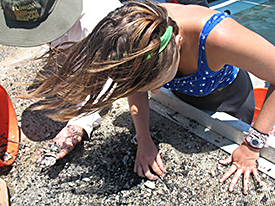
Sarah Everhart sorts through dredge spoil topside.
Friday was all set to be a normal day. Both boats were in working order and the crew was ready, but yet again we were delayed due to a split anchor line. The crew had to reattach the barge to the anchor line and haul it back to its original location once again. Due to the delay, there was only time for one dive. Team 3 finished dredging the amidships unit down to the bottom of level 1, some divers took a tour of the site, and Team 2 searched for the ballast pile at the EPI site. The end of the day was marked with high winds and heavy chop and the crew left the barge earlier than usual to clean up and begin their weekends after a long week of hard work!
Please feel free to contact us if you have any questions or concerns at: mua@keimaps.com.
Return to Project Journal home page.
